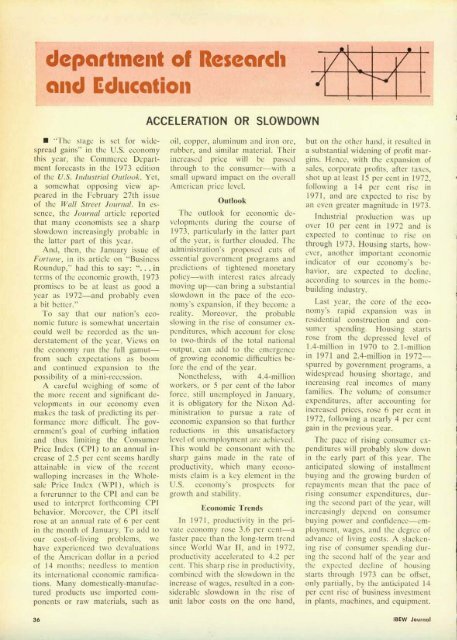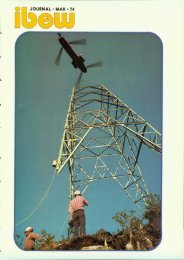1973-04 April IBEW Journal.pdf - International Brotherhood of ...
1973-04 April IBEW Journal.pdf - International Brotherhood of ...
1973-04 April IBEW Journal.pdf - International Brotherhood of ...
Create successful ePaper yourself
Turn your PDF publications into a flip-book with our unique Google optimized e-Paper software.
departlnent <strong>of</strong> Research<br />
and Ed'ication<br />
ACCELERATION OR SLOWDOWN<br />
• .. rh..: \(ugo.: is ~..:t for wide<br />
.-,prcad guin~" in Ih..: U.S. cl'onllmy<br />
this ycar, Ih~ C()l1lm~'rcc Ikpaftmen!<br />
foro.:casts in tho.: <strong>1973</strong> edition<br />
<strong>of</strong> the U.S. /I/(/mlria/ Ow/vol.. Yo:t.<br />
a somewhat opposing vicw up<br />
J>l.'an:d in the February 27th iS~lIo.:<br />
<strong>of</strong> the !Vall Sfrt'el lUl/rlwl. In essence,<br />
Ihe JO//l"/la/ article rcporlo.:d<br />
that many ..:conomists see a l>harp<br />
slowdown increasingly probabk in<br />
the latter p:lrt or (hb year.<br />
And. then. thl' January issue <strong>of</strong><br />
FlJrllllU'. in ils arlicle on "Bu... in c\'~<br />
Roundup," had this to say: "... in<br />
terms <strong>of</strong> the economic growth. <strong>1973</strong><br />
prnmiscs to be at feasl as good a<br />
year a:. ]l)72-and probably even<br />
a bit bcltcr."<br />
To !oay that our nalion\ economic<br />
ftHure I:' ::,olllcwhal uncertain<br />
coulll well be rccorckd as tilt' un<br />
(h,:rstatcm..:nt <strong>of</strong> the ).:ar. Vil'WS on<br />
the economy run the full gamutfrolll<br />
such expectation" as boom<br />
and continul':d cxpan).ion to the<br />
pussibility <strong>of</strong> i\ lI1ini -rece~s ion.<br />
A l:iudul \vcishins <strong>of</strong> somc <strong>of</strong><br />
the mon.: reccnt and :.ignificant development:.<br />
ill our economy even<br />
makes th .:- task <strong>of</strong> predicting its per<br />
formance more diflicult. The go\'<br />
ernment":. gO:11 <strong>of</strong> curbing intJation<br />
and thus limiting tho.; Consumcr<br />
Price 1 ndcx (CPI) to an annual illcrea).e<br />
<strong>of</strong> 2.5 pl'r cent seems hardly<br />
at(ainabk in view <strong>of</strong> the f\·c·l"rlt.<br />
walloping incrca).cs in the Whole<br />
).alc Price IrKkx (WPI ). which i:-,<br />
a fnrcrullIll'r 10 the C PI and corn he<br />
u,>cd 10 imcrprl't forthcoming C PI<br />
behavior. Morcowr. the cpr ihelf<br />
Tu:.e at an annual rate <strong>of</strong> 6 per cent<br />
in the month <strong>of</strong> January. To add to<br />
OUT co~ t -()f-living problems, wc<br />
have expcricllced two dl':valuation ..<br />
<strong>of</strong> the American dollar in a period<br />
<strong>of</strong> 14 month).: ncedJc~~ to mention<br />
its intt'rllalional cconomic ramifie:ltions.<br />
Many domestIcally-manufactured<br />
products usc imported COrllponcnts<br />
or raw materials, such as<br />
oil, copper, aluminum anu iron 01'1..\<br />
rublK'r, i\nu ).il1lilar material. Thdr<br />
in!;fI:>r"'':i.I price will be pa!>..,ed<br />
through 10 the consuml'r~with a<br />
,mall upw:lru impact on the overall<br />
Amcrican pricc Ic\'d.<br />
Oullook<br />
The outlOOK for economic Jcvclopments<br />
Juring the cour!>c <strong>of</strong><br />
<strong>1973</strong>. particularly in thl': laller p:lrI<br />
<strong>of</strong> the )ear. i~ further clouded. The<br />
::rdmini~tnrtiun·'" propoM:d Cllts <strong>of</strong><br />
c'»enll:11 government program'> an(1<br />
prcdktilllh <strong>of</strong> tightcn..:d monctary<br />
pohcy~\\lth Ir1tere~t r(ltes already<br />
moving up---can bring a sub!>tantial<br />
~ lowJO\\n in the pacc <strong>of</strong> the economy's<br />
~'xpamion, if they becoml.) (l<br />
rl':ality. Morcovcr, the probabk<br />
slowing in the riSl' <strong>of</strong> consumer expo.!nuiture~.<br />
which account for do~<br />
to two-third ... uf the lowl n:ltional<br />
o utput. clIn add to the l'mcrg..:nce<br />
<strong>of</strong> growing economic difficulties befo<br />
re thl! cud <strong>of</strong> the year.<br />
NOlldhck..,.." with 4A-million<br />
workcr~. or 5 per C~llt <strong>of</strong> the labor<br />
fon:l·. still uncmployeu in January.<br />
it h obligatory for thc Nixon Ad·<br />
ministr:ltion 10 pur~uc a rate <strong>of</strong><br />
cconomic cxpansion so that furthl.'r<br />
reductions in Ihis un ~at i s facto ry<br />
Icwl <strong>of</strong> urll'mployment nr,' ;'lchi\'vccl.<br />
This would bc con:.onant with the<br />
sharp g:lins made in the rate <strong>of</strong><br />
prouuctivity, which many ecollomi..,b<br />
claim i, a I..cy dement in thc<br />
U.S. l'COnOrH} 's prosp.:cls for<br />
growth and ~lab ilil\ .<br />
Economic T re nds<br />
In 1971. productivity in the priv>rtc<br />
economy rose 3.6 pel' cent-a<br />
fa).tl'r pael': than the long-term trend<br />
since World War I I, and ill 1972.<br />
productivit}' accekr.Hcd to 4.2 I)C~<br />
~ent. This ).harp ris..: in productivity,<br />
combinl'd with the ).I{muown in the<br />
increase or wage).. re).ulied in a considerablc<br />
slowdown in the ri).e <strong>of</strong><br />
unit labor costs on the onc hand,<br />
but on the oth ... r hand, il rl'~ultl'd in<br />
a ).ub!>tantial widening <strong>of</strong> pr<strong>of</strong>it margim.<br />
Hence, with thc ('xpan).ion <strong>of</strong><br />
salcs, corporate pr<strong>of</strong>ib. after taxl.!s,<br />
..,hot up :n 1e:I..,t 15 per c\.·nt in 1972,<br />
f\)lIowing a 14 per cent ri~ in<br />
1971. and arc eXpl'(·ted to ri,c b}<br />
an ewn greatcr IlwgnilUu,,: in 11)73.<br />
IncJmtrinl prnductinn wa.., up<br />
over 10 pcr cent in 1912 and i,<br />
expected 10 continue to ris..: on<br />
throu,gh <strong>1973</strong>. HOUlIillg Slarh, ho\\<br />
ever. another important ..:conomic<br />
inuicator <strong>of</strong> our econom)·:. behavior.<br />
afe \.·xpected (0 t1cclin..:.<br />
according 10 \0urc('s in the homebuilding<br />
indu~lry.<br />
Last yellr. the core <strong>of</strong> the l':COnomy').<br />
rapid ex pansion was ill<br />
rC'iidcntial comlruction and con<br />
,>umer ,>pending Hom,i ng :.tarts<br />
rose from the depre:;!>ed level <strong>of</strong><br />
lA-million in 1970 to 2.I-million<br />
in 1971 and 2.+tlIillion in 1972-<br />
,purrcd by govcrnment programs, a<br />
widespread housing shortage, :111(1<br />
increasing rea l irl!;(Jmes <strong>of</strong> many<br />
families. The volume <strong>of</strong> con).Ul11l':1'<br />
c .. pcnditurc).. after accounting for<br />
increal>l:d pl'ice:;, rose 6 per cent in<br />
1972. folio" ing a nearly 4 per ccnt<br />
gain in the pre\'jous year.<br />
Thl' pacl' <strong>of</strong> rising consuml..'r I.'Xp..:nditllfl':"<br />
will probably slow dC)\\ll<br />
in the carly part <strong>of</strong> this ycar. The<br />
anticipated ,lowing <strong>of</strong> imtllllJllcnt<br />
buying and thc growing burden <strong>of</strong><br />
repaymenb illl'un that the pace <strong>of</strong><br />
ri~illg COIl:.Ull1er ('xpcnditllfe!>, dur<br />
IlIg thl' '>ecnnd part <strong>of</strong> the ycar, \\ill<br />
inercu!>ingl} ul']>end on COIl!>Ulller<br />
bu) ing powcr and confidencc-employment.<br />
wagl's, and the degree <strong>of</strong><br />
advanc(' <strong>of</strong> li\ ing costs. A ~hlckening<br />
ri~c <strong>of</strong> enn,utllcr spending durrng<br />
thl': ~econd half <strong>of</strong> the ycar and<br />
the expcct ... d ucdim: <strong>of</strong> housing<br />
Mans through <strong>1973</strong> can be o ff:.ct.<br />
only p;lrLiully, b) the anticijJ:tku 14<br />
per cent rise <strong>of</strong> bu.!.ines:. inw:.tmcnl<br />
in plants, machines. and equipment.<br />
r8EW Jou,nClI
















